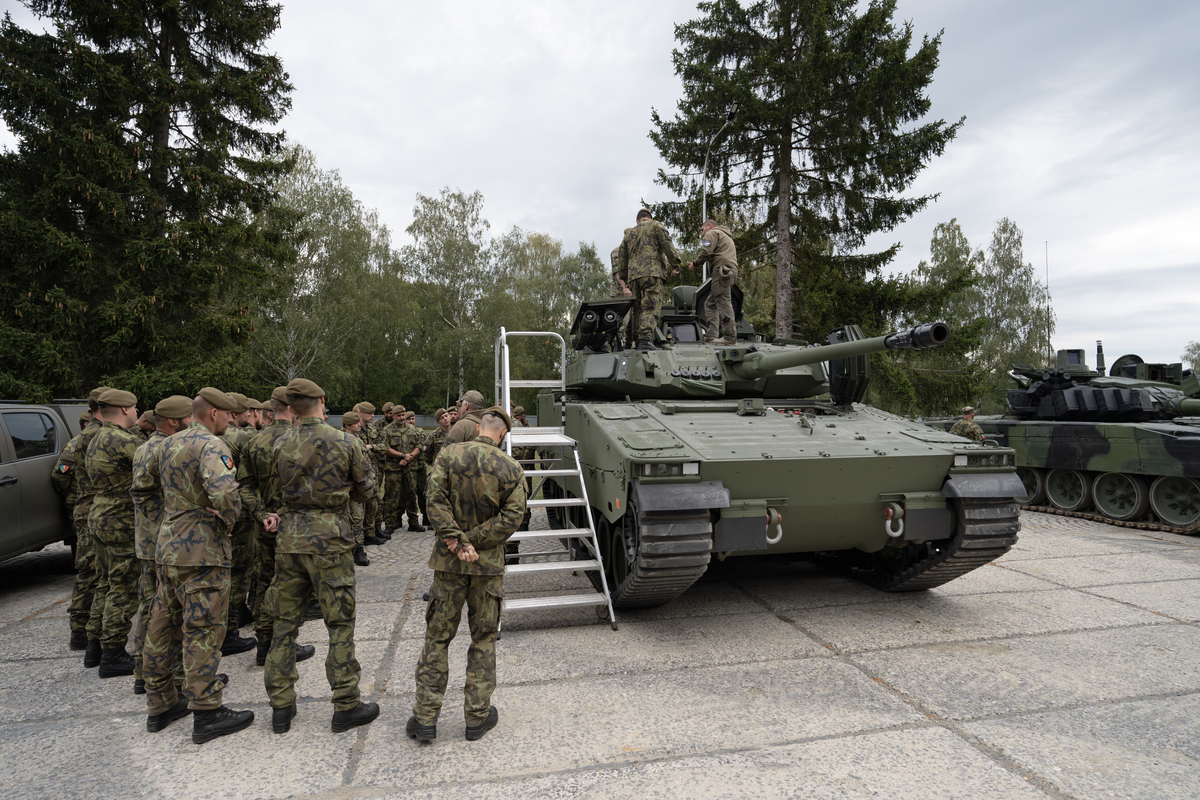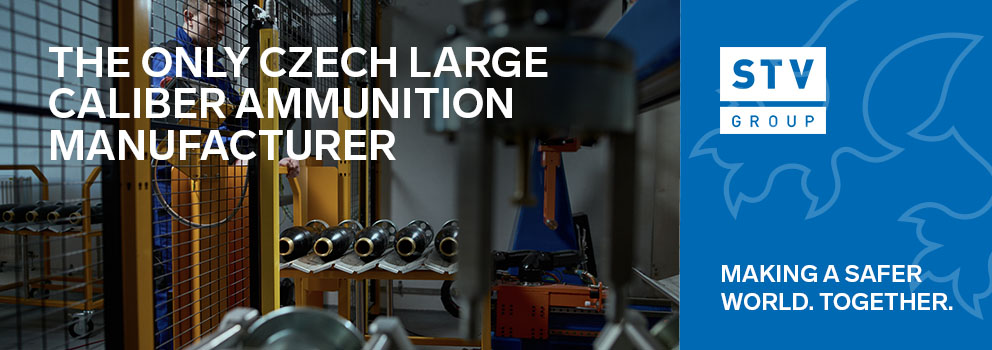Gen. Zdeněk Mikula: I told our soldiers that the challenges ahead will certainly not be easy
The 7th Mechanised Brigade "Dukelská" celebrated its 30th anniversary this year. Over its history, this, the only "heavy brigade" of the Army of the Czech Republic, has undergone various changes. Currently, it consists of a headquarters (with a support company and a liaison company) and four subordinate units: the 71st Mechanised Battalion "Siberian," stationed in Hranice; the 72nd Mechanised Battalion "Major General Josef Buršík"; the 73rd Tank Battalion "Hanácké," both based in Přáslavice; and the 74th Mechanised Battalion "Colonel Bohuslav Maleček," located in Bučovice. We discussed the current state and challenges of the heavy brigade with its commander, Brigadier General Zdeněk Mikula.
Video: Interview with the Commander of the 7th MB, Brigadier General Zdeněk Mikula / CZ DEFENCE
General, the 7th Mechanised Brigade "Dukelská" is our only heavy brigade. What is the current state of its technical equipment?
As far as backbone combat equipment is concerned, we still use BVP-2 vehicles. However, when it comes to tank troops, we are already looking forward to better times. We are introducing Leopard 2A4 tanks, which are older but of Western design, which is important for us. Furthermore, we are about to acquire more tanks based on this type, specifically the Leopard 2A8 version, which is state-of-the-art. Additionally, the tender for tracked infantry fighting vehicles from BAE Systems is just around the corner. The CV90, which is a proven design tested in various conflicts and operations, is part of this tender.

You have already had the opportunity to see the CV90 in person. What were your first impressions, and what is the feedback from the soldiers?
I have personally been familiar with the CV90 for about 10 years, having been involved in this tender from the beginning. For a long time, we promised our soldiers that they would receive new combat vehicles, but it didn’t happen. So being able to bring the first CV90 to Přáslavice with the support of BAE Systems, to show it to the soldiers, explain how it works, discuss its strengths and weaknesses, and highlight the key areas for training was an incredible experience. Our soldiers perceived it as a tangible sign that these vehicles are coming, and the opportunity to delve into the technical details was highly appreciated.

Is it fair to say that the CV90 was your preferred vehicle in the tender?
I wouldn’t say I had a preferred choice during the tender. However, from the beginning, we emphasized that we wanted a proven vehicle, and the CV90 fits that requirement.
The 7th Mechanised Brigade isn’t just about machines; it’s about people. How are you doing in terms of personnel?
We’ve increased our staffing tables in preparation for the CV90, allowing us to start recruiting the additional soldiers we’ll need due to the higher number of combat vehicles compared to the existing ones. This increase has naturally affected our manning levels on paper, as we’ve opened new positions that we’re actively working to fill. We aim to attract the younger generation, and we see the new combat equipment as one of the key motivators for them to join us.
Despite this temporary "artificial" decline, we’re relatively well-staffed. There are other factors influencing recruitment, including a generational shift. The young people joining us today are different—not worse, just different. We need to adapt to them without lowering the standards we aim to achieve. Young recruits place more value on an organization’s culture, how they are treated, and the spirit of the unit—elements that help them feel passionate about their role.
How did the Voluntary Military Exercise (VME) you organized with the 4th Rapid Deployment Brigade this summer contribute to these efforts?
I think it was an excellent idea and a great initiative. Today’s younger generation often lacks information about the army—how it works and what it’s like to be a soldier. Many of their parents didn’t experience basic military service, so for them, the military is something unfamiliar and, in some cases, intimidating. The VME allowed us to show high school students how the army operates. Whether their impressions are positive or not, it’s valuable for them to have this information to help them decide whether they want to join the military.
How challenging was the preparation? Did you have to adapt much from standard military training?
I’d like to emphasize that we didn’t compromise on standards. While we treated the participants somewhat like teenagers initially—many instructors used their own parenting experience to establish communication—we managed to engage and motivate them for training. As a result, we achieved the same standards we uphold during standard basic training courses in Vyškov.
Are there any other opportunities for young people to get a sense of life in the 7th Brigade?
We try to ensure that recruits can visit our barracks, as not everyone is suited to this job, and it’s important to determine early on if this path is right for them. Allowing them to see where they’ll go after basic training helps clarify their direction. We also engage the public through events like the Mud Event, the largest event for ground forces, and by supporting the Air Force during NATO Days in Ostrava. These events help people connect with us and gain a better understanding of our role.
Are there specific professions or skills you need in greater numbers?
We could use more personnel across all roles, from officers to vehicle crews and mechanized platoons conducting combat operations. Through the active reserve program, we are specifically targeting positions that are currently vacant or those likely to be heavily burdened during combat operations. Active reserves are an integral part of the 7th Mechanised Brigade. They train with us to the same standards and on the same equipment.

You're currently training on Leopard 2A4 tanks. The target state for your brigade is to acquire Leopard 2A8 tanks. How challenging was the transition to this type of tank? What had to change?
The first and most significant change was the number of soldiers in the crew. We have an extra man now. Previously, this position was called a loader, but for us, it is now referred to as an operator because it involves much more than simply loading a round into the barrel. This position requires additional skills and responsibilities. Historically, our tanks included this role, but the T-72M4 CZ tanks we currently operate have an automatic loader, so there was one less crew member.
Another major adjustment was the shift in mindset, particularly in training management. We had to learn to rely more on simulators, similar to how the German Army operates. Establishing cooperation with the Austrian Army, which uses the same type of tanks, has been incredibly helpful.

Maintaining these vehicles is another significant shift. The Leopard is not a simple tank; it’s highly capable but requires much more time and effort in maintenance and repair. Proper maintenance ensures the reliability we need, but neglecting it will cause the tank to fail. This adjustment requires a change in mindset, and such changes can sometimes be difficult.
Does the higher manning requirement of the Leopard impact tactics, particularly with the shift from automatic to manual loading?
Slightly, yes, but I don't believe it fundamentally alters tactics. What has changed is the number of tanks per platoon—we now have four tanks per platoon. Additionally, both the company commander and deputy company commander have their own command tanks, allowing for much better maneuverability within the tank company.
One of the advantages of the Leopard tank is its accuracy, correct?
Absolutely. The Leopard’s accuracy is one of its standout features. With these tanks, you can truly appreciate German precision. Our soldiers were initially skeptical when they learned they would be operating an older tank. However, once they had the chance to sit in the Leopard, fire it, and use it tactically, their attitudes changed quickly.
How is the 7th Brigade handling Leopard tank mobility, particularly over long distances?
The Czech Army has acquired transport assets like heavy-duty trailers and tractors capable of moving the Leopards efficiently. These resources are managed by the logistics support regiment and are made available to us as needed.
The CV90 IFVs and the Leopard tanks represent a significant influx of new equipment. Will this require changes to the current maintenance system?
Yes, it will. We are learning from countries already operating this equipment. For example, we are members of the LEOBEN club, which focuses on Leopard tanks and their modifications, and the CV90 user club. These memberships allow us to study other users' maintenance and logistics systems and adapt their best practices.
One of the biggest changes is adopting modern training methods, such as using simulators for about 70% of the training and conducting the remaining 30% on actual equipment. This approach saves resources and extends the life of our combat equipment while improving training efficiency.
What benefits has membership in LEOBEN brought to your brigade?
The benefits of being part of user groups like LEOBEN are seen in the medium to long term. Membership allows us to share training and logistics capabilities and collaborate on solutions to common challenges. It also enables us to collectively pressure system suppliers, which is more effective than acting alone.
The 7th Brigade also trains Ukrainian soldiers. How has that experience been?
It’s a unique and valuable experience. Training our Ukrainian colleagues not only helps them enhance their capabilities to resist Russian aggression but also provides us with insights from the conflict. After every training cycle, we seek updates on the war’s progress and use that information to refine our practices—not just for our brigade but for the entire Army.
Early in the war, there were claims that tanks were obsolete. Has the battlefield in Ukraine proven otherwise?
The war in Ukraine has shown that while new technologies like drones are critical, mechanized and tank units remain essential. Infantry must still enter and control territory, and tanks are vital for enabling that. This underscores the importance of finding synergies between modern technologies and traditional forces.
Has the use of drones influenced your training and tactics?
Yes, significantly. We’ve returned to practices like dispersing equipment, camouflaging, altering battle formations, and avoiding prolonged stays in one location. These tactics were somewhat neglected during our long-term deployments in asymmetric conflicts but are now essential again. We also monitor advancements in anti-drone technology and adapt our training accordingly.
Is the brigade involved in developing drone protection systems?
Not directly. The nature of the conflict defines the threats, and we provide feedback on what needs protection. The lessons from Ukraine drive the development of new systems, which we follow closely.
How is the 7th Brigade performing in international exercises?
When participating in foreign exercises, we’ve seen that despite using older equipment, our soldiers excel at maximizing its potential. This ability, combined with their motivation and preparation, is something to be proud of.
The brigade’s combat equipment is being updated, but what about other equipment and armaments?
Although our core combat vehicles are outdated, we have modernized all small arms, making them NATO-compatible. These weapons, produced by the Czech Armaments Factory, have proven reliable and continue to be improved in collaboration with the manufacturer.
Additionally, we’ve introduced TITUS wheeled armored vehicles in liaison and staff versions, which have been integrated into our training. This aligns with lessons from Ukraine, emphasizing the need for mobile command posts to reduce vulnerability.
How does the 7th Brigade’s equipment compare to other armies?
Our neighboring countries are on similar modernization paths. For example, Poland leads in rearmament, but it also faces logistical challenges with its diverse range of tanks. Hungary and Slovakia are acquiring new Leopards and IFVs, aligning with NATO standards. Compared to older NATO members, many still rely on CV90s, which reinforces our choice of equipment.
Is having multiple tank types an advantage or a complication?
It’s a logistical challenge, but it can also be advantageous if tanks are allocated appropriately. Poland’s approach, acquiring both Abrams and K2 tanks due to limited market availability, illustrates this. The K2, for example, is among the best tanks available today.

As brigade commander, what goals did you set, and what have you achieved?
Our primary goal has been transitioning to a new force model and implementing regional plans active from January 1 next year. Alongside this, we’ve faced challenges such as rearmament and responding to natural disasters, including recent events in the Moravian-Silesian and Olomouc regions. We stand ready to deploy wherever needed.
This year marks the brigade’s 30th anniversary. What did you wish your soldiers during the celebrations?
Anniversaries are a time to reflect on the past, honor those who didn’t return, and celebrate our camaraderie. Looking ahead, I wished our soldiers continued team spirit, motivation, and readiness for the challenges ahead. With new equipment, we can achieve even more and build on the 7th Mechanised Brigade’s proud legacy.




















